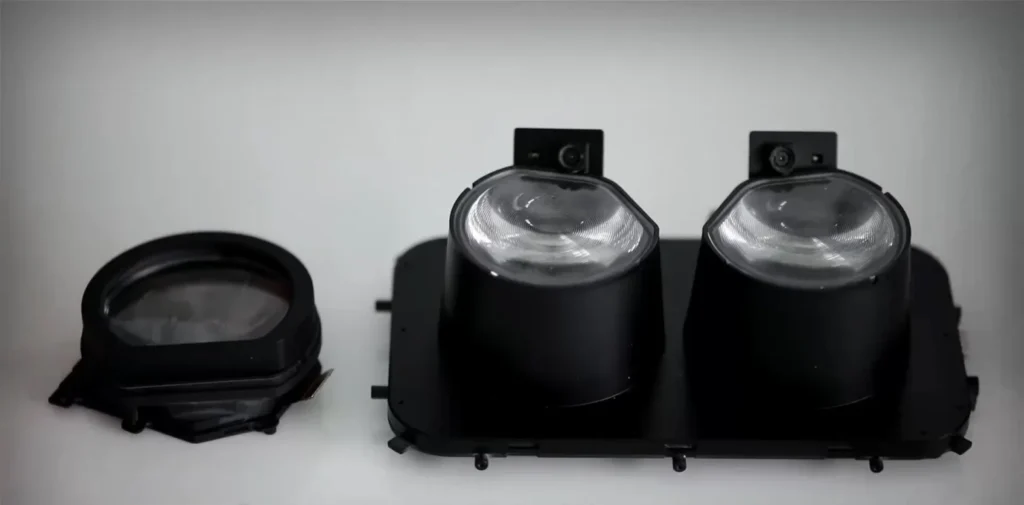Introduction: The Need for Thinner Optics
As consumer electronics continue to shrink while demanding higher performance, traditional lens systems face limitations in size and weight. Pancake optical modules have emerged as an innovative solution, enabling ultra-thin designs without sacrificing optical quality. These folded optics are revolutionizing industries from augmented reality to medical imaging by packing powerful optical performance into remarkably compact form factors.
The technology’s name comes from its flat, layered structure resembling a stack of pancakes—a dramatic departure from the long barrels of conventional lenses. This breakthrough couldn’t have come at a better time, as manufacturers across multiple sectors struggle to balance performance with consumer demands for sleeker, lighter devices.
How Pancake Optical Module Work
The Physics of Light Folding
At their core, pancake modules manipulate light through a carefully choreographed sequence of polarization and reflection. Unlike traditional lenses that guide light straight through glass elements, these systems fold the light path back on itself using specialized optical components.
Key Components and Their Roles
Four critical elements work together to achieve the pancake optic’s magic:
- Input polarizer establishes the initial light polarization
- Polarizing beam splitter directs light based on polarization state
- Quarter-wave plate modifies the light’s polarization characteristics
- Curved reflector focuses light while completing the folded path
This elegant arrangement allows the optical system to achieve equivalent performance to much longer traditional lenses in a fraction of the space.

Manufacturing Challenges and Breakthroughs
Precision Alignment Requirements
Building pancake optical modules demands extraordinary precision, with component alignments often requiring accuracy within 0.1 degrees. Modern manufacturing addresses this through:
- Computer-controlled active alignment systems
- High-resolution machine vision for real-time feedback
- Advanced adhesives that maintain positioning during curing
Coating Technology Advancements
The specialized optical coatings in pancake modules must maintain perfect polarization control across the entire surface. Recent developments in thin-film deposition techniques have enabled:
- More durable coating formulations
- Better performance across wider wavelength ranges
- Improved manufacturing yield rates
Industry Applications and Impact
Augmented and Virtual Reality
AR/VR headsets have benefited enormously from pancake optics. The Meta Quest Pro, for example, uses this technology to achieve:
- 40% reduction in thickness compared to previous designs
- Improved edge-to-edge clarity
- Larger “eyebox” for more comfortable viewing
Smartphone Camera Systems
Mobile device manufacturers face constant pressure to deliver better cameras in thinner phones. Pancake optics enable:
- High-quality periscope zoom lenses in sub-6mm packages
- Improved image stabilization
- Multi-camera arrays with professional-grade performance

Performance Tradeoffs and Considerations
While pancake modules offer remarkable advantages, engineers must consider several factors when implementing them:
Light Efficiency
The multiple reflections and polarization conversions typically result in about 15% light loss compared to conventional lenses. This makes proper illumination design crucial, especially for low-light applications.
Thermal Stability
The layered construction with different materials requires careful thermal management to prevent performance degradation in extreme temperatures.
Cost Considerations
Current manufacturing complexity makes pancake optical modules more expensive than traditional optics, though prices continue to decrease as production volumes increase.
The Future of Pancake Optical Module
Researchers are exploring several exciting directions for advancing the technology:
Meta-Optic Integration
Combining pancake designs with nanostructured meta-surfaces could enable even thinner systems with novel optical capabilities.
Active Tunable Systems
Liquid crystal layers may allow dynamic adjustment of optical properties for variable focus or adaptive imaging.
Mass Production Scaling
New manufacturing techniques promise to further reduce costs, potentially bringing the technology to more consumer applications.
Conclusion: A Transformative Optical Technology
Pancake optical modules represent more than just another incremental improvement—they constitute a fundamental shift in optical design philosophy. By folding light rather than passing it straight through, engineers have overcome what were once considered fundamental limitations in optical miniaturization.
As the technology continues to mature, we can expect to see pancake optical module enabling entirely new categories of devices and applications. From medical diagnostics to consumer electronics to defense systems, this innovative approach to light manipulation is poised to play a central role in the next generation of optical systems.
